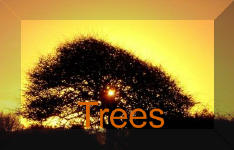BACK TO


Beech (Fagus sylvatica)
BACK TO


Synonymys
Irish Fea (Family - Fagaceae)
The scientific or Latin name Fagus derives from the Greek phagein, meaning 'to eat' (the nuts are edible). Sylvatica is a reference to woodland.The common name comes from the Norse buche or bok which also means book. Thin sheets of beech wood were used before paper was perfected. Early book covers were also made of wood.Description: Magnificent, large, deciduous tree. Important economic forestry tree. Height: Max 40m. Age: mature at 120 years
Description
Woodland Beech is a tall deciduous tree up to 40 m in height with a straight, clean trunk.is a straight lofty tree, but in open country it produces a broadly spreading head of branches often on a short stem.
Leaves
They are silky and hairy when young, but this is soon lost.The untoothed pointe oval leaves have 5-9 parallel veins. They emerge gossamer fringed in late May but soon become deep green as the fringe is cast off. The leaves are oval, 4-9 cm long and are borne alternately on the twigs. The margins are untoothed and slightly wavy or have a few blunt teeth. The stalk is short, about 10 mm long.
Bark
The bark is grey and smooth, but may break into small squares
Buds
The winter buds, on fine zigzag shoots, are spindle shaped and sharply pointed. Their golden-brown gives distant beech woods a distinctive colour.
Numerous male and female flowers appear with the leaves. The hanging bunches of male flowers quickly fall and litter the ground with pale brown confetti that blows in the wind. Female ones stay on the tree until autumn and develop into spiked woody husks each containing a pair of triangular glossy-brown nuts. trees and the ground below them may be covered in the prickly husks, each containing two nutlets, which develop from tiny female flowers.Beech trees are relatively short lived, seldom lasting over 250 years. Large specimens often become top heavy and fall over. Stem and branch failure may occur very rapidly in old age.
Location:
It is commonest on lime-rich soils and is widely planted throughout the UK.Likes Chalky soils and limestone but tolerant of a wide range of soils and conditions. Up to 300m Natural distribution in Southern England to Gloucestershire and a few localities in South Wales. Not native to Ireland.Found throughout most of Europe except Spain, Former USSR, Norway and Sweden.
Phenology:
Flowers Leaves Fruit Ripen Fall
Apr-May Mar-Apr October Nov-April
Catkins
Wildlife
Little else will grow under the dense shade cast by beech trees in full leaf. Dry leaf clippings of the Beech are good for hedgehogs
Growth and Propagation :
Grown from seed. Scaly cup splits in Autumn to release 2 three sided nuts. Seed should be moist chilled for approx 12 weeks before sowing. Approx 3000 germinable seeds per Kg. Best established when sheltered by birch or hazel coppice. Frost tender. Increases in size to 120 years.
Past & Present Uses
Pale brown hard wood but relatively easily worked.Healthy timber is pinkish-brown with small darker flecks. Over mature wood infected by fungi is also prized. Called 'dozed beech' it exhibits patches of orange, brown and creamy white.Chairmakers in the Chilterns were called 'bodgers' and once worked in the woods turning the legs on primitive lathes. This is a craft that has recently been reintroduced in some rural areas of the UK. Whitest wood considered to be best grade.Large trees for timber. Not suitable for outside use although used for piles immersed in water. Used for furniture and many other uses such as bowls, spoons, tools, plywood, and veneers. Valuable as sawn timber. Good for firewood and production of charcoal. Food and drink - The nut is known as mast and occurs in abundance every five to eight years. It is nutritious and rich in oil and attractive to birds and small mammals including deer and badger. The oil can be extracted and used for culinary purposesYoung trees and those trimmed for hedges retain their leaves throughout the winter
.